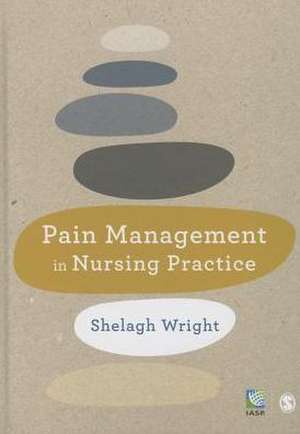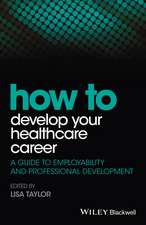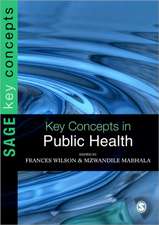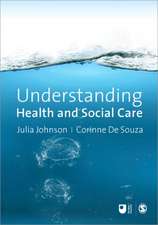Pain Management in Nursing Practice
Autor Shelagh Wrighten Limba Engleză Paperback – 8 dec 2014
Based on the curriculum developed by the International Association for the Study of Pain, this book offers an essential guide to managing pain. Beginning with an examination of the biology of pain, it then goes on to consider pain management across the life course, looking at key topics including acute pain, cancer pain and pharmacology. Case scenarios are included throughout the book to help readers apply the knowledge they have learned to their own practice.
This book is aimed primarily at meeting the learning needs of undergraduate nurses, and is essential reading for all healthcare professionals studying pain. The text will be helpful as a basic foundation for more advanced postgraduate courses in pain management in nursing practice.
| Toate formatele și edițiile | Preț | Express |
|---|---|---|
| Paperback (1) | 413.40 lei 6-8 săpt. | |
| SAGE Publications – 8 dec 2014 | 413.40 lei 6-8 săpt. | |
| Hardback (1) | 1246.02 lei 6-8 săpt. | |
| SAGE Publications – 8 dec 2014 | 1246.02 lei 6-8 săpt. |
Preț: 413.40 lei
Preț vechi: 435.15 lei
-5% Nou
Puncte Express: 620
Preț estimativ în valută:
79.13€ • 85.98$ • 66.51£
79.13€ • 85.98$ • 66.51£
Carte tipărită la comandă
Livrare economică 21 aprilie-05 mai
Preluare comenzi: 021 569.72.76
Specificații
ISBN-13: 9781446282007
ISBN-10: 1446282007
Pagini: 336
Dimensiuni: 170 x 242 x 18 mm
Greutate: 0.57 kg
Ediția:1
Editura: SAGE Publications
Colecția Sage Publications Ltd
Locul publicării:London, United Kingdom
ISBN-10: 1446282007
Pagini: 336
Dimensiuni: 170 x 242 x 18 mm
Greutate: 0.57 kg
Ediția:1
Editura: SAGE Publications
Colecția Sage Publications Ltd
Locul publicării:London, United Kingdom
Recenzii
'I would see this book being used as one of a few being used on my course, possibly even a core text. It is the most up to date and interesting text on the subject.'
Julie Macdonald, Lecturer, University of Hull
'This book is appropriate for undergraduate students. The discussion is concise and flows logically.'
Meriel Swann, Senior Lecturer and Programme Director MSc Pain Management, Birmingham City University
Other potential contacts for endorsement:
Meriel Swann, Lecturer at KCL
A good overview for those with less experience of the topic and but enough depth for those with more knowledge. I look forward to using the book on my course.
An up to date and interesting read for student nurses and qualified practitioners.
Acute or chronic pain, non-malignant pain, or cancer pain and palliative care, the details of the management by the clinical team are all covered in this judicious book. The physiology of stress and a discussion of coping strategies and psychological, non-pharmacological approaches and complimentary therapies are also considered. It is bang up to date with a rich and fascinating chapter on pain and human rights, at both national and international government level. Although the book is aimed primarily at meeting the learning needs of undergraduate nurses, it will also provide the basic foundation for more advanced postgraduate courses in pain management in nursing practice. I consider it to be essential reading for all healthcare professionals studying pain.
I am in the middle of reading [the] new book “Pain management in nursing practice” and have been very impressed with its contents and general readability. I particularly liked the “Biopsychosocial model of pain: rehumanizing care, which was very well written and included a large number of quality quotations from very reputable authors. I felt that chapter very much set the scene for the remainder of the book. I am very much looking forward to reading the remainder of the book and have already asked our library to obtain a copy for student use. I have recommended it to my colleagues who teach pain management to under-graduate students.
Its strengths lie in the authors’ ability to take complex and sometimes difficult to understand concepts and explain them in comprehensible English, a considerable skill and worthy of note. The case studies are carefully constructed and serve to reinforce the text well with some useful question and answers to follow and I particularly liked the bullet pointed chapter summaries, which for hard pressed clinicians give a good concise overview of the content. Appendices one and two offer a well structured and useful chart of all the most common pain relieving drugs carefully categorised user friendly. Many nurses will find this helpful. The website references are useful and there is some fascinating discussion in areas such as the history of pain and the nature of suffering, which add real gravitas to this book..As a reference text for study, this book is an invaluable aid for the students of today and rightly deserves its place on recommended reading lists and on the bookshelves of qualified nurses alike.
Overall a very easily read book which I believe should be included on the reading list for all undergraduate nursing curricula.
Undergraduate nursing students will find that it provides a useful resource in their understanding and learning about pain as it affects patients in their care in different clinical placement experiences. More experienced, registered nurses will, however, find it a useful resource to consolidate their knowledge of pain and in specialist areas of care.
Julie Macdonald, Lecturer, University of Hull
'This book is appropriate for undergraduate students. The discussion is concise and flows logically.'
Meriel Swann, Senior Lecturer and Programme Director MSc Pain Management, Birmingham City University
Other potential contacts for endorsement:
Meriel Swann, Lecturer at KCL
A good overview for those with less experience of the topic and but enough depth for those with more knowledge. I look forward to using the book on my course.
An up to date and interesting read for student nurses and qualified practitioners.
Acute or chronic pain, non-malignant pain, or cancer pain and palliative care, the details of the management by the clinical team are all covered in this judicious book. The physiology of stress and a discussion of coping strategies and psychological, non-pharmacological approaches and complimentary therapies are also considered. It is bang up to date with a rich and fascinating chapter on pain and human rights, at both national and international government level. Although the book is aimed primarily at meeting the learning needs of undergraduate nurses, it will also provide the basic foundation for more advanced postgraduate courses in pain management in nursing practice. I consider it to be essential reading for all healthcare professionals studying pain.
I am in the middle of reading [the] new book “Pain management in nursing practice” and have been very impressed with its contents and general readability. I particularly liked the “Biopsychosocial model of pain: rehumanizing care, which was very well written and included a large number of quality quotations from very reputable authors. I felt that chapter very much set the scene for the remainder of the book. I am very much looking forward to reading the remainder of the book and have already asked our library to obtain a copy for student use. I have recommended it to my colleagues who teach pain management to under-graduate students.
Its strengths lie in the authors’ ability to take complex and sometimes difficult to understand concepts and explain them in comprehensible English, a considerable skill and worthy of note. The case studies are carefully constructed and serve to reinforce the text well with some useful question and answers to follow and I particularly liked the bullet pointed chapter summaries, which for hard pressed clinicians give a good concise overview of the content. Appendices one and two offer a well structured and useful chart of all the most common pain relieving drugs carefully categorised user friendly. Many nurses will find this helpful. The website references are useful and there is some fascinating discussion in areas such as the history of pain and the nature of suffering, which add real gravitas to this book..As a reference text for study, this book is an invaluable aid for the students of today and rightly deserves its place on recommended reading lists and on the bookshelves of qualified nurses alike.
Overall a very easily read book which I believe should be included on the reading list for all undergraduate nursing curricula.
Undergraduate nursing students will find that it provides a useful resource in their understanding and learning about pain as it affects patients in their care in different clinical placement experiences. More experienced, registered nurses will, however, find it a useful resource to consolidate their knowledge of pain and in specialist areas of care.
Cuprins
Leaders in Pain Care: An Historic Overview
The Biopsychosocial Model of Pain: Rehumanizing Care
The Neuropsychophysiology of Pain
Epidemiology of Chronic Pain
The Assessment and Measurement of Pain
Communication in Pain Management
Pharmacological and Interventional Pain Management
Acute Pain
Chronic Non-Malignant Pain
Cancer Pain
Pain Management in Palliative Care and at End of Life
Stress Management and Non-Pharmalogical Interventions for Pain
Quality, Safety and Organizational Issues in Pain Management
Pain and Human Rights
The Biopsychosocial Model of Pain: Rehumanizing Care
The Neuropsychophysiology of Pain
Epidemiology of Chronic Pain
The Assessment and Measurement of Pain
Communication in Pain Management
Pharmacological and Interventional Pain Management
Acute Pain
Chronic Non-Malignant Pain
Cancer Pain
Pain Management in Palliative Care and at End of Life
Stress Management and Non-Pharmalogical Interventions for Pain
Quality, Safety and Organizational Issues in Pain Management
Pain and Human Rights
Descriere
Based on the curriculum developed by the International Association for the Study of Pain, this book offers an essential guide to managing pain. Beginning with an examination of the biology of pain, it then goes on to consider pain management across the lifecourse, looking at key topics including acute pain, cancer pain and pharmacology.







